A Sweet Slice of History: American Dessert Pies and More
歴史の甘い一切れ:アメリカのデザートパイとその仲間たち
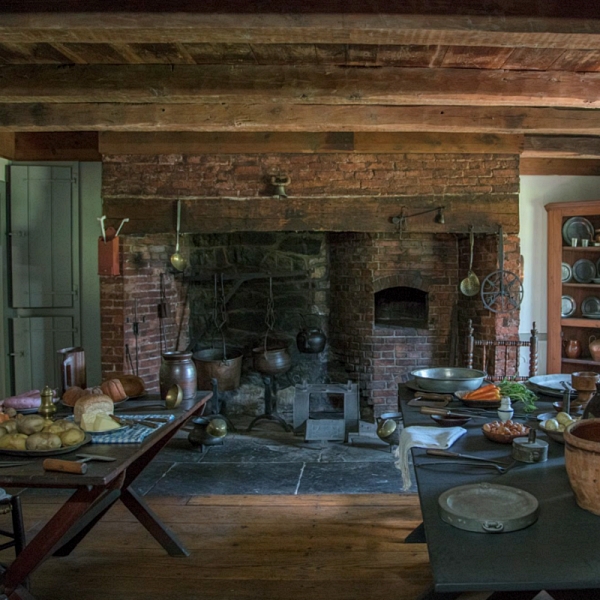
アーリーアメリカンキッチン(レプリカ)
American dessert pies trace their origins to the early settlers who adapted their European pie-making traditions to the ingredients available in the New World. The concept of pie itself dates back to ancient Egypt and Greece, where they were more like meat-filled pastries. The Romans, known for their culinary ingenuity, spread pie-making throughout Europe. By the time European settlers arrived in America, pies had become a staple of English cuisine.
Early American pies were savory, but the abundant variety of fruits and sweeteners in the New World led to the development of dessert pies. By the 18th century, sweet pies became popular, with recipes appearing in early American cookbooks like “American Cookery” by Amelia Simmons, published in 1796.
アメリカのデザートパイは、初期の移住者がヨーロッパのパイ作りの伝統を新大陸で入手可能な食材に適応させたことに由来します。パイの概念自体は古代エジプトとギリシャに遡り、当時は肉を詰めたペストリーのようなものでした。ローマ人はその料理の才を活かし、パイ作りをヨーロッパ全土に広めました。ヨーロッパの移住者がアメリカに到着する頃には、パイはイギリス料理の定番となっていました。
初期のアメリカのパイは塩味が主流でしたが、新大陸で豊富に手に入る果物や甘味料のおかげでデザートパイが発展しました。18世紀までには甘いパイが人気となり、1796年にアメリア・シモンズによって出版された「American Cookery」などの初期のアメリカ料理本にレシピが登場しました。
The Law of Pies
パイの基本法則
First Law of Pies: Pies must have a pastry made from some sort of grain, wheat, rice, cracker or cookie crumbs. No pastry, No pie!
パイは小麦粉、米、クラッカー、またはクッキーのクラムなどから作られたペストリーを持たなければなりません。ペストリーがない場合、パイとは呼べません!
Second Law of Pies: Pies must be baked in an oven at some time of the process. Pies are not fried, boiled or steamed.
パイはプロセスのいずれかの時点でオーブンで焼かれなければなりません。
Third Law of Pies: Pies must be baked in some form of a dish – metal, ceramic or glass.
パイは揚げたり、茹でたり、蒸したりしません。
Fourth Law of Pie: Pies in America must have a bottom crust of some sort of pastry.
パイは金属、セラミック、またはガラスの器で焼かれなければなりません。アメリカのパイには何らかのペストリーのボトムクラストが必要です。
Fifth Law of Pie: A pie must have a pastry that comes up on the sides to contain its filling. A tart is a subset of the pie. If sides are perpendicular, filled with custard and topped with fruit, the pie is called a tart.
パイはそのフィリングを保持するために側面にペストリーを持たなければなりません。タルトはパイのサブセットです。側面が垂直で、カスタードで満たされ、果物でトッピングされた場合、そのパイはタルトと呼ばれます。
From everythingPIES.com
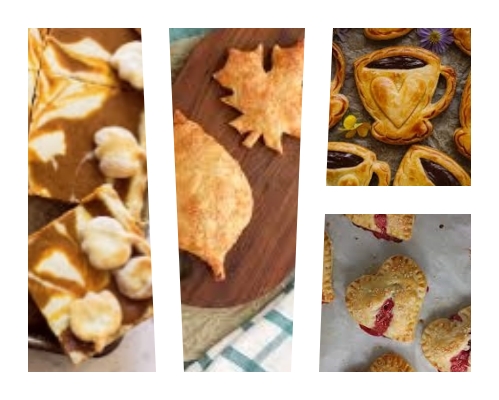
Shapes
Traditional American pies are typically round, with a sloped edge and a fluted or crimped crust. They are generally 23 to 30 centimeters in diameter, though hand pies (small, portable versions) and slab pies (rectangular pies baked in a sheet pan) also enjoy popular.
形状
伝統的なアメリカのパイは通常、丸く、縁が傾斜していて、波形またはクランプされたクラストを持ちます。直径は一般的に23〜30センチメートルですが、手のひらサイズのパイ(小さくて持ち運びが簡単なもの)や、スラブパイ(シートパンで焼かれる長方形のパイ)も人気です。
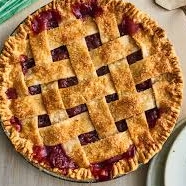
伝統的なチェリーパイ
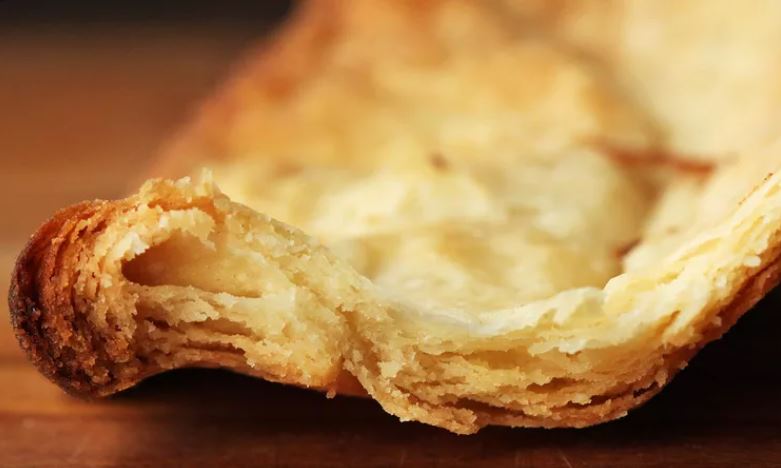
Ingredients
The base of most American pies consists of a buttery, flaky crust made from flour, fat (butter or shortening), and water. Fillings vary widely:
材料
ほとんどのアメリカのパイの基本は、小麦粉、脂肪(バターまたはショートニング)、水で作られたバターのようにフレーク状のクラストです。フィリングは多岐にわたります:
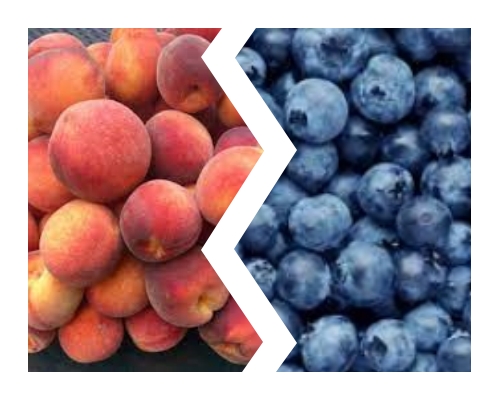
Fruits
Apples, cherries, peaches, blueberries, and pumpkins (botanically a fruit but usually treated as a vegetable) are among the favorites.
果物
りんご、さくらんぼ、桃、ブルーベリー、かぼちゃ(植物学的には果物ですが、通常は野菜として扱われます)が人気です。
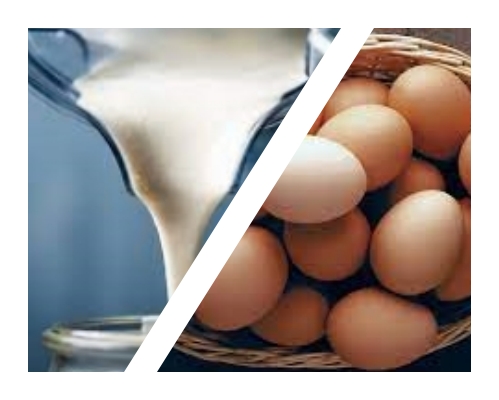
Custards
Eggs, sugar, and milk or cream form the base for pies like custard and buttermilk pie.
カスター
卵、砂糖、ミルクまたはクリームを基にしたカスタードパイやバターミルクパイ。
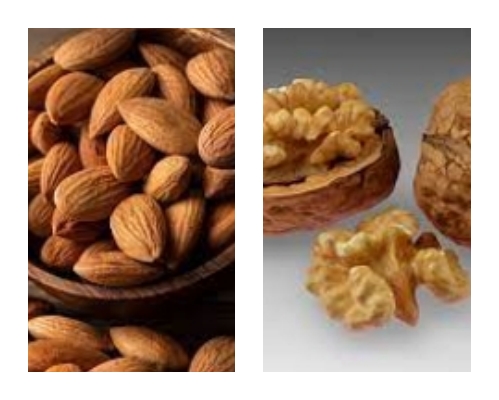
Nuts
Pecans, walnuts and other nuts feature prominently in Southern pies.
ナッツ
ペカンやその他のナッツは南部のパイに多く見られます。
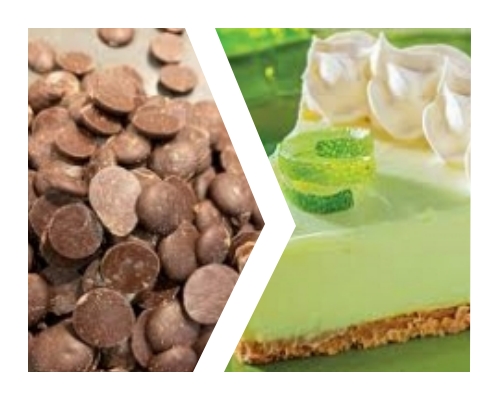
Chocolate and Cream
Modern versions include chocolate, coconut cream, lemon, and key lime pies.
チョコレートとクリーム
ペカンやその他のナッツは南部のパイに多く見られます。
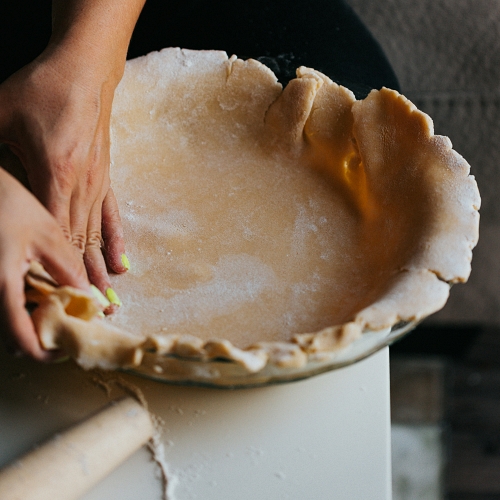
生地をパイ皿に敷く
Basic Steps
- Crust Preparation: Combine flour and salt, cut in cold butter or shortening until crumbly, and add ice water to form a dough. Chill the dough before rolling it out.
- Rolling and Shaping: Roll the dough into a circle and place it in a pie dish. Trim and crimp the edges.
- Filling: Prepare the filling, whether fruit, custard, or nut-based. For fruit pies, toss the fruit with sugar, spices, and a thickener like cornstarch.
- Assembly: Pour the filling into the prepared crust. Top with a second crust, lattice, or crumb topping if desired.
- Baking: Bake in a preheated oven until the crust is golden and the filling is bubbling. Baking times and temperatures vary by pie type.
基本的な作り方
- クラストの準備: 小麦粉と塩を混ぜ、冷たいバターまたはショートニングを切り込み、ボロボロになるまで混ぜ、氷水を加えて生地を作ります。生地を冷蔵庫で冷やしてから伸ばします。
- 伸ばして形作る: 生地を円形に伸ばし、パイ皿に敷きます。縁を切り取り、波形またはクランプします。
- フィリング: 果物、カスタード、ナッツなどのフィリングを準備します。果物のパイの場合、果物を砂糖、スパイス、コーンスターチのような増粘剤で和えます。
- 組み立て: 準備したクラストにフィリングを注ぎます。必要に応じて、2つ目のクラスト、ラティス、またはクランブルトッピングを追加します。
- 焼く: 予熱したオーブンでクラストが黄金色になり、フィリングが泡立つまで焼きます。焼き時間と温度はパイの種類によって異なります。
Regional favorites
地域のお気に入り
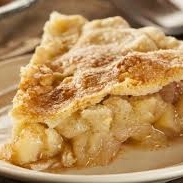
Northeast
Known for its apple pies, often with a crumb topping, and Boston cream pie (which is actually a cake).
北東部
クランブルトッピングを載せたアップルパイや、実際にはケーキであるボストンクリームパイが有名です。
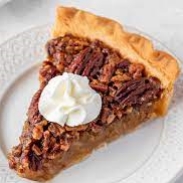
South
Famous for pecan pie, sweet potato pie, and buttermilk pie. Key lime pie is a Floridian specialty.
南部
ペカンパイ、スイートポテトパイ、バターミルクパイが有名です。キーライムパイはフロリダの名物です。
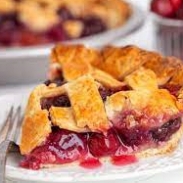
Midwest
Cherry pie and rhubarb pie are popular, reflecting the region’s abundant fruit harvests.
中西部
チェリーパイやルバーブパイが人気で、この地域の豊富な果物の収穫を反映しています。
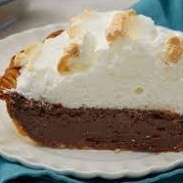
West
Berry pies like marionberry in Oregon and boysenberry in California and the always favorite chocolate cream, along with the influence of Latino culture seen in pies like tres leches.
西部
オレゴンのマリオンベリーパイやカリフォルニアのボイセンベリーパイ、チョコレートクリームパイが人気で、トレスレチェスのようなラテン文化の影響も見られます。
Holiday Specialties
ホリデーの特別な一品
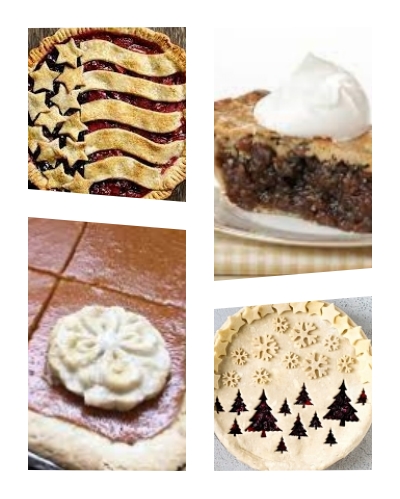
Pies play a central role in American holiday celebrations. Thanksgiving is synonymous with pumpkin pie, a tradition dating back to the early 19th century. Apple pie, dubbed “as American as apple pie,” is also a staple, often served with a slice of cheddar cheese or a scoop of vanilla ice cream. Pecan pie and sweet potato pie, with their rich, warm flavors, are Southern favorites on Thanksgiving and Christmas tables.
During the Fourth of July, berry pies, often decorated with stars and stripes, celebrate the nation’s independence. Christmas brings a variety of pies, with mincemeat pie, a holdover from British traditions, making a nostalgic appearance in some homes.
From their early savory beginnings to the sweet confections enjoyed today, American dessert pies have evolved into a beloved part of the nation’s culinary heritage. Each region has its specialties, and holidays bring out the best in pie-making traditions. Whether filled with fruit, custard, nuts, or chocolate, pies offer a comforting and delicious slice of Americana.
パイはアメリカの祝日の中心的な役割を果たしています。感謝祭といえば、19世紀初頭に遡る伝統であるパンプキンパイが思い浮かびます。アップルパイも「アメリカの象徴」として知られ、チェダーチーズのスライスやバニラアイスクリームと共に提供されることが多いです。ペカンパイとスイートポテトパイは、感謝祭やクリスマスの食卓に並ぶ南部の定番です。
7月4日には、星条旗のデコレーションを施したベリーパイが独立記念日を祝います。クリスマスには、イギリスの伝統を引き継いだミンスミートパイが懐かしさを感じさせる家庭もあります。
初期の塩味から今日の甘い菓子まで、アメリカのデザートパイは国の料理遺産の愛される一部として進化してきました。各地域にはその特産品があり、祝日には最高のパイ作りの伝統が引き出されます。果物、カスタード、ナッツ、またはチョコレートで満たされたパイは、アメリカの心地よく美味しい一片を提供してくれます。
Classic American Cobblers, Crisps, Crumbles and more…
アメリカの伝統的なデザート「コブラー」「クリスプ」「クランブル」など
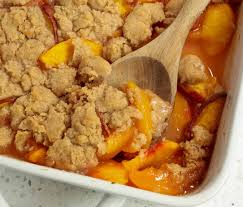
ピーチコブラー
Cobbler
Cobblers are baked desserts with a fruit filling and a biscuit-like topping, but this varies regionally. In the South, the topping is often dropped in dollops (resembling cobblestones, hence the name “cobbler”), while other regions bake the fruit with a more cohesive pastry crust. Cobblers originated in the American colonies when English settlers adapted pie recipes with simpler, locally available ingredients. Peach and blackberry cobblers are particularly beloved in the Southern U.S.
コブラー
コブラーは果物をフィリングにしたデザートで、上にはビスケット風の生地が乗っていますが、その形は地域によって異なります。アメリカ南部では「石畳」(cobblestone)のように生地をスプーンで落とすスタイルが一般的ですが、他の地域ではペイストリーのようにフルーツを覆うこともあります。コブラーはアメリカ植民地時代に、イギリスからの入植者が地元の材料で作りやすいレシピにアレンジしたことが発祥です。特に南部では、ピーチコブラーやブラックベリーコブラーが人気です。
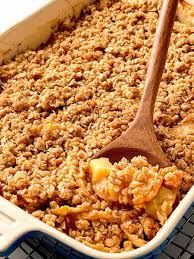
アップルクリスプ
Crisp
A crisp is similar to a cobbler but is topped with a mixture of butter, sugar, flour, and oats that “crisp” up when baked. This topping creates a crunchy, crumbly layer over the baked fruit. Oats were introduced to the recipe during the 20th century, although the dish itself dates back to the 19th century. Apple crisp, a quintessential fall dessert, is probably the most well-known, but crisps can be made with any in-season fruit.
クリスプ
クリスプはコブラーに似ていますが、トッピングはバター、砂糖、小麦粉、オーツ(オートミール)で作られ、焼くと「クリスプ」(パリパリ)とした食感になります。このオーツ入りのトッピングが、果物のフィリングにサクサクの層を作ります。19世紀に誕生し、20世紀にオーツが取り入れられたこのデザートは、特に秋にはアップルクリスプが有名ですが、旬の果物を使ってアレンジが可能です。
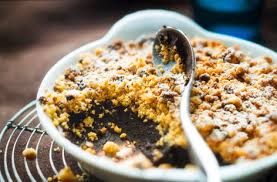
ブルーベリークランブル
Crumble
A crumble is almost identical to a crisp but without the oats. Instead, it’s a simple blend of flour, butter, and sugar, making the topping slightly softer and less crunchy than a crisp. Crumbles originated in England and became popular during World War II due to rationing, as they required fewer ingredients than a traditional pie. The distinction between crumbles and crisps is often fluid, as many American cooks use the terms interchangeably.
クランブル
クランブルはクリスプに非常に似ていますが、オーツが含まれない点で異なります。小麦粉、バター、砂糖だけを混ぜて作るため、クリスプよりも少し柔らかいトッピングになります。クランブルはイギリス発祥で、第二次世界大戦中の食材配給時代にシンプルな材料で作れることから人気を集めました。アメリカではクリスプとクランブルが混同されることが多いです。
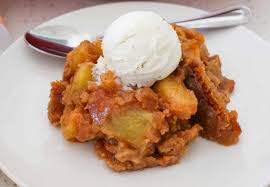
ブラウン・ベティ
Brown Betty
Brown Betty desserts layer fruit with spiced breadcrumbs or crumbs, then bake them to a soft, warm consistency. Apple Brown Betty, the most popular version, has roots in the American colonies, dating back to the early 19th century. Its preparation is straightforward, making it a favorite during times when simple, affordable ingredients were prized.
ブラウン・ベティ
ブラウン・ベティは、果物をスパイス風味のパン粉やクラム(クッキーやパンの砕いたもの)で層状に重ねて焼き、柔らかく温かいデザートに仕上げます。最も有名な「アップルブラウン・ベティ」は、19世紀初頭のアメリカ植民地時代から愛されてきたレシピです。シンプルな材料で作れるため、手軽で親しみやすいデザートです。
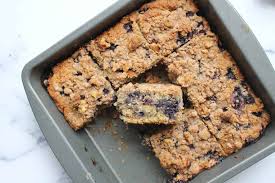
ブルーベリーバックル
Buckle
A buckle combines a cake-like batter with fruit, typically berries, that “buckles” as it bakes, giving it a rustic appearance. Unlike cobblers and crisps, buckles include leavening, creating a dessert that’s halfway between a cake and a pudding. Blueberry buckle is a New England classic and is commonly enjoyed as both dessert and breakfast.
バックル
バックルは、ケーキのような生地と果物(主にベリー類)を組み合わせ、焼くと生地が「バックル」(崩れる)ような外観になります。コブラーやクリスプと異なり、膨張剤が入っているため、ケーキとプディングの中間のようなデザートになります。特にブルーベリーバックルはニューイングランド地方の定番で、デザートだけでなく朝食としても楽しまれます。
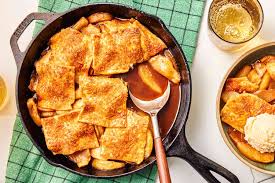
アップルパンダウディ
Pandowdy
Pandowdy is a deep-dish fruit dessert similar to cobbler but with a pastry crust that’s usually broken up (“dowdied”) during baking to let the juices seep into the crust. This colonial-era dessert was popularized by early American settlers who wanted a way to stretch scarce ingredients. Apple and molasses pandowdies are especially well-known, and some recipes use leftover pie dough.
パンダウディ
パンダウディは、コブラーに似た深皿の果物デザートですが、ペイストリーの生地が使用され、焼く途中で生地を崩して(「ダウディ」)果物のジュースが染み込むように仕上げます。この植民地時代のデザートは、材料を無駄にせず作る方法として広まりました。特にアップルパンダウディやモラセス(糖蜜)パンダウディが有名で、残ったパイ生地を活用するレシピもあります。
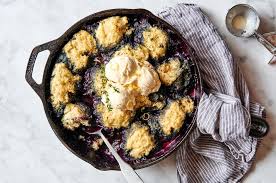
ブルーベリーグラント
Grunt / Slump
These two desserts are essentially the same, though “grunt” is more common in New England and “slump” in the Midwest. They’re like a stovetop cobbler, where fruit is simmered with a biscuit topping, which steams rather than bakes. The names reflect the “grunting” or “slumping” sound of the fruit as it bubbles under the biscuit topping. These are often made with berries or stone fruits and are usually served straight from the skillet.
グラント/スランプ
この2つのデザートは本質的には同じで、ニューイングランドでは「グラント」、中西部では「スランプ」と呼ばれます。果物とビスケット生地を鍋で煮込み、蒸して仕上げる、いわば「ストーブトップ・コブラー」です。ビスケット生地の下で果物が「グラン」や「スランプ」と音を立てて煮込まれる様子が名前の由来です。ベリーやストーンフルーツを使うことが多く、スキレットからそのまま供されることが多いです。
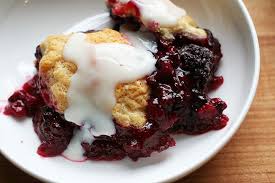
ブラックベリーソンカー
Sonker
A lesser-known dessert, the sonker is specific to North Carolina, particularly in the Appalachian region. It’s similar to a cobbler but has a deeper filling and a slightly more liquid consistency, almost like a cross between cobbler and fruit pudding. Sweet potato and berry sonkers are regional favorites, and there’s even an annual sonker festival in North Carolina.
ソンカー
ソンカーはあまり知られていないデザートですが、ノースカロライナ州、特にアパラチア地域に特有のものです。コブラーに似ていますが、フィリングが厚く、少し液体の多い仕上がりで、コブラーとフルーツプディングの中間のような食感になります。サツマイモやベリーを使ったソンカーが人気で、ノースカロライナには毎年ソンカーフェスティバルも開催されています。
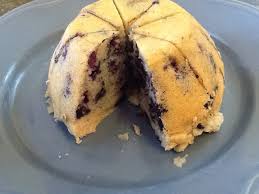
ベリーダフ
Duff
Duff is a steamed dessert that is similar to a grunt but originated in the Caribbean and New England. Traditionally made with wild berries and sometimes even with a boiled dumpling-like topping, it became popular in the northeastern U.S., especially in areas with British colonial ties. The duff can be baked or steamed and is often served with a simple custard sauce.
ダフ
ダフはグラントに似た蒸しデザートで、カリブ海やニューイングランドが発祥です。伝統的には、野生のベリーや茹でたダンプリングのようなトッピングとともに作られ、特にイギリス植民地の影響が強い北東部で人気となりました。ダフは蒸したり焼いたりでき、シンプルなカスタードソースと一緒に供されることが多いです。
Betty’s Cousins: Roly-Poly and Bird’s Nest Pudding
ブラウン・ベティの親戚:ロリーポリーとバードネストプディング
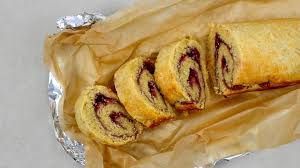
ジャムロリーポリー
Roly-Poly
Roly-poly is a British pastry brought to the U.S., featuring jam or fruit rolled in dough and baked or steamed. It’s not as common today but has roots in traditional American colonial cuisine.
ロリーポリー
ロリーポリーは、イギリスからアメリカに伝わったペイストリーで、ジャムや果物を生地で巻き、焼いたり蒸したりして作ります。現在ではあまり見かけませんが、アメリカ植民地時代の伝統的なデザートに由来します。
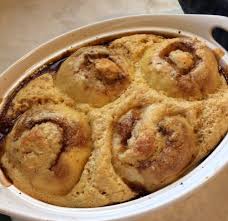
バーズネストプディング
Bird's Nest Pudding
- This unique dessert uses whole apples cored and stuffed with sugar or raisins, then baked in a custard-like batter. Popular in New England, it combines the appeal of baked apples with pudding.
• バードネストプディング
- このユニークなデザートは、丸ごとのリンゴの芯をくり抜き、砂糖やレーズンを詰めて、カスタードのような生地で焼きます。ニューイングランドで人気があり、焼きリンゴとプディングの魅力を組み合わせています。
Meringue Mastery: Tips for Perfect Toppings
and Troubleshooting Common Issues
メレンゲのマスター:理想的なトッピングの秘訣とよくある問題の対策
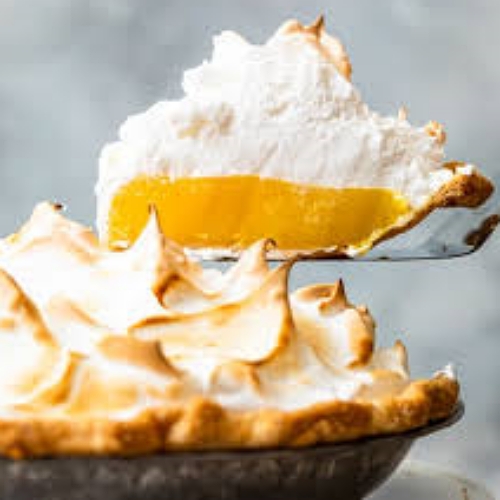
クラシックレモンメレンゲパイ
Whether it’s a classic soft meringue with fluffy peaks or the stable, glossy finish of Swiss meringue, mastering meringue is all about technique and attention to detail. Here’s everything you need to know to make the perfect dessert topping, troubleshoot common issues, and store meringue-topped creations.
ふんわりとしたピークのあるソフトメレンゲから、安定した艶のあるスイスメレンゲまで、完璧なメレンゲを作るには、テクニックと細部へのこだわりが重要です。理想的なデザートトッピングを作り、よくある問題を解決し、メレンゲトッピングのデザートを保管する方法について詳しく説明します。
Types of Meringues: Soft and Swiss
メレンゲの種類:ソフトメレンゲとスイスメレンゲ
- Soft Meringue: This is the go-to for a pillowy, lighter texture, typically whipped up with egg whites and sugar until soft peaks form. Soft meringue is quick to prepare and adds a beautiful, light topping to pies and other desserts. However, it’s more prone to shrinking and weeping, which can affect its look and texture if not managed carefully.
- ソフトメレンゲ:軽い質感が特徴で、卵白と砂糖を使って柔らかいピークが立つまで泡立てます。簡単に作れて、パイや他のデザートの美しい軽いトッピングになりますが、縮んだり水分が出たりしやすく、見た目や質感に影響を与えることがあります。
- Swiss Meringue: Known for its glossy, firm structure, Swiss meringue is a great choice for more stability. It’s made by whisking egg whites and sugar together over a double boiler until the mixture reaches around 71°C, then beating it until stiff peaks form. This cooking process makes Swiss meringue more stable, less prone to weeping, and less likely to shrink, making it ideal for decorative piping and long-lasting toppings.
- スイスメレンゲ:艶があり、しっかりとした安定性を持つスイスメレンゲは、安定したトッピングに最適です。卵白と砂糖を湯せんで71℃ほどまで加熱しながら泡立て、しっかりとしたピークができるまで泡立てます。この過程により、スイスメレンゲは安定し、縮んだり水が出にくくなるため、デコレーションや長持ちするトッピングに最適です。
Meringue Problems and Solutions
メレンゲの問題と解決策ゲ
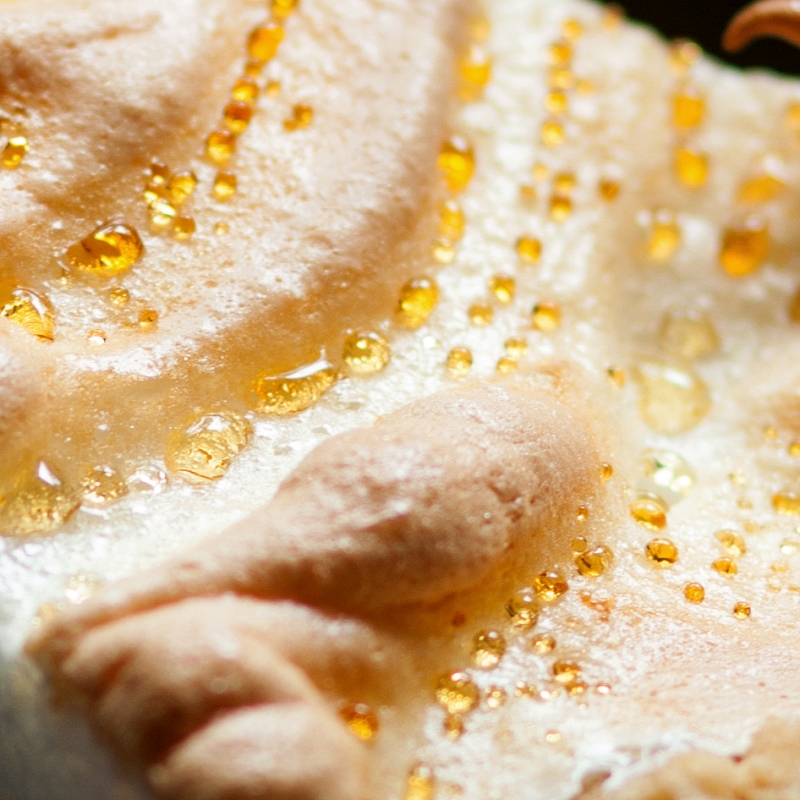
ビーディング
Beading
Beading (sugary droplets on the meringue) often results from overcooking or undissolved sugar.
Solution: Make sure sugar is fully dissolved into the egg whites to reduce the risk. Bake the meringue briefly at a higher temperature, like 220ºC for 4-5 minutes, or consider torching the meringue to achieve an even color without prolonged heat exposure.
ビーディング(砂糖の小滴がメレンゲ表面に現れること)
過度の加熱や砂糖が完全に溶けていない場合に起こります。
対策:卵白に砂糖が完全に溶け込むようにし、高温(220℃で4~5分)の短時間で焼くか、料理用バーナーで均一な焼き色を付けるのが効果的です。
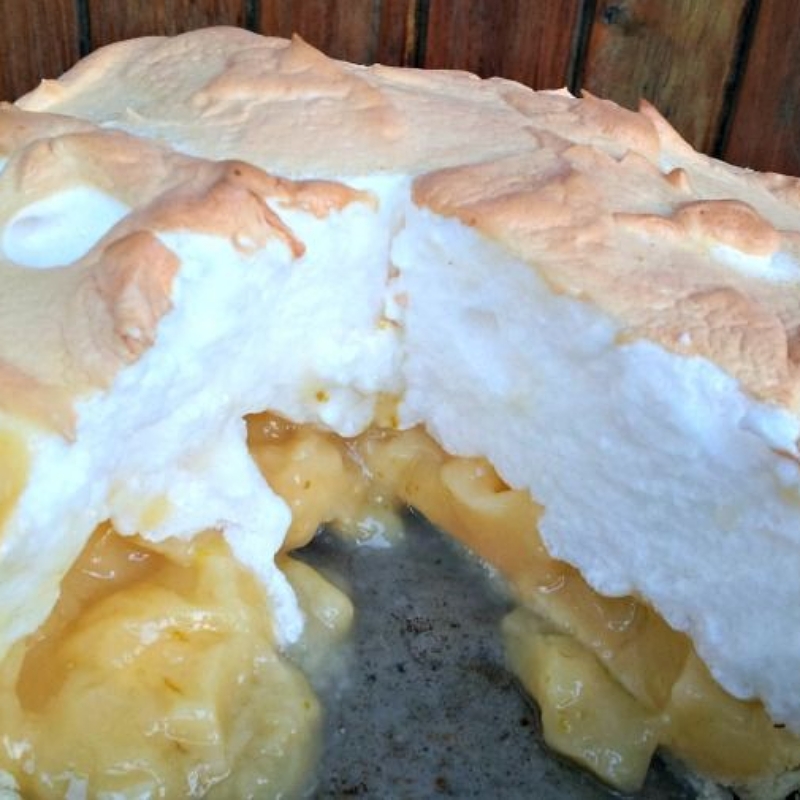
ウィーピング
Weeping
Weeping (water pooling between the meringue and the filling) occurs due to undercooking or moisture absorption.
Solution: Start with a hot filling before applying meringue, sealing it well along the edges of the crust to trap heat and cook the meringue from below. Sprinkling fine cake crumbs, vanilla wafer crumbs, or soft white bread crumbs over the filling will absorb liquid between the meringue and the pie filling, which will also prevent weeping.
ウィーピング(メレンゲとフィリングの間に水が溜まること)
調理不足や湿気の吸収が原因です。
対策:熱いフィリングにメレンゲを載せ、端をしっかり密封することで熱を閉じ込め、下からメレンゲを調理します。フィリングにケーキの細かいクラムやバニラウェハーのクラムをまぶすことで、フィリングとメレンゲの間に水が溜まるのを防ぎます。

縮み
Shrinking
Shrinking, or volume loss, usually happens because of over-beating or instability.
Solution: For extra stability, dissolve ½ tsp of cornstarch in 2 tsp of water per 2 egg whites and heat gently until smooth. Once cooled, add this mixture to the whipped egg whites just before spreading it on the pie.
縮み(ボリュームの減少)
過剰な泡立てや不安定さが原因です。
対策:より安定させるために、コーンスターチ1/2小さじを水2小さじで溶かし、滑らかになるまで軽く加熱します。冷えたら、この混合物を泡立てた卵白に加え、パイに塗る直前に混ぜます。
Browning
焼き色を付ける方法
Once the meringue is ready and shaped, it’s time to cook or brown it for a beautiful, golden finish. Here are two common methods:
メレンゲを仕上げて形を整えたら、美しい黄金色に焼き上げる時間です。以下の方法が一般的です:
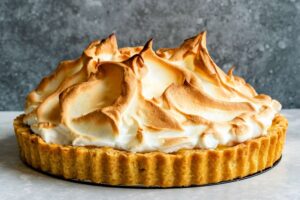
こんがり焼いたメレンゲ
- Oven Browning: For a consistent color and gentle finish, bake the meringue in the oven at a moderate temperature, around 160°C for 15-20 minutes, or until the top is a light golden brown. If you’re finishing a Swiss meringue, you may want to bake it at a slightly lower temperature for a longer time to avoid overcooking.
- オーブンでの焼き色付け:均一な色合いと穏やかな仕上がりを目指す場合、オーブンを160℃に設定し、メレンゲの表面が薄い黄金色になるまで15~20分焼きます。スイスメレンゲの場合は、長時間焼かないよう、やや低温で焼くことをおすすめします。
- Cooking Torch: A kitchen torch is a quick way to caramelize the top and add beautiful color without fully baking the meringue. Move the torch in a circular motion over the meringue to prevent scorching, and keep it about 5-cm away from the surface. This technique is especially useful for delicate desserts where you don’t want to expose them to additional baking time.
- 料理用バーナー:キッチンバーナーを使うと、メレンゲ全体を焼かずに、上部を素早くカラメル化させ、きれいな焼き色をつけることができます。メレンゲの約5㎝上から円を描くように動かし、焦げないように注意します。この方法は、追加の焼き時間を避けたいデリケートなデザートに特に便利です。
Storing Desserts with Meringue Toppings
メレンゲトッピングのデザートの保存
Meringues are best enjoyed fresh, but with the right techniques, you can preserve them for a bit longer without sacrificing too much quality:
メレンゲはできたてを楽しむのが一番ですが、適切な保存方法で少し長持ちさせることも可能です:
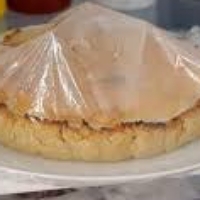
メレンゲの冷蔵保存
- Room Temperature (for same-day serving): Desserts with meringue toppings can usually be kept at room temperature for a few hours. Just cover them lightly to protect from dust or humidity.
- 常温保存(当日提供する場合):メレンゲトッピングのデザートは通常数時間常温で保管できます。軽くカバーしてホコリや湿気から保護してください。
- Refrigeration: For overnight storage, a refrigerated environment is ideal. Swiss meringue holds up better in the fridge due to its stability, while soft meringue may start to lose texture and can sometimes begin to weep. To avoid these issues, place desserts in a cake container with a loose lid rather than wrapping them, as this reduces moisture contact and helps maintain structure.
- 冷蔵保存:翌日まで保存する場合は、冷蔵庫が理想的です。スイスメレンゲはその安定性により冷蔵保存に適していますが、ソフトメレンゲは質感を失いやすく、湿気の影響で水分が出やすくなります。密閉せず、ケーキの保存容器に緩く蓋をすることで、湿気の接触を減らし、構造を保つことができます。
- Freezing: Freezing meringue-topped desserts is generally not recommended, as meringues can become gummy when thawed due to moisture changes. If you must freeze, Swiss meringue is the better option, and freezing individual servings or uncovered items for just an hour or two may help retain some texture.
- 冷凍:冷凍保存は一般的に推奨されません。メレンゲは、解凍時に湿気の変化でゴムのような食感になりやすいためです。どうしても冷凍したい場合は、スイスメレンゲが良い選択で、個別のポーションや一時的に冷凍するのが効果的です。

